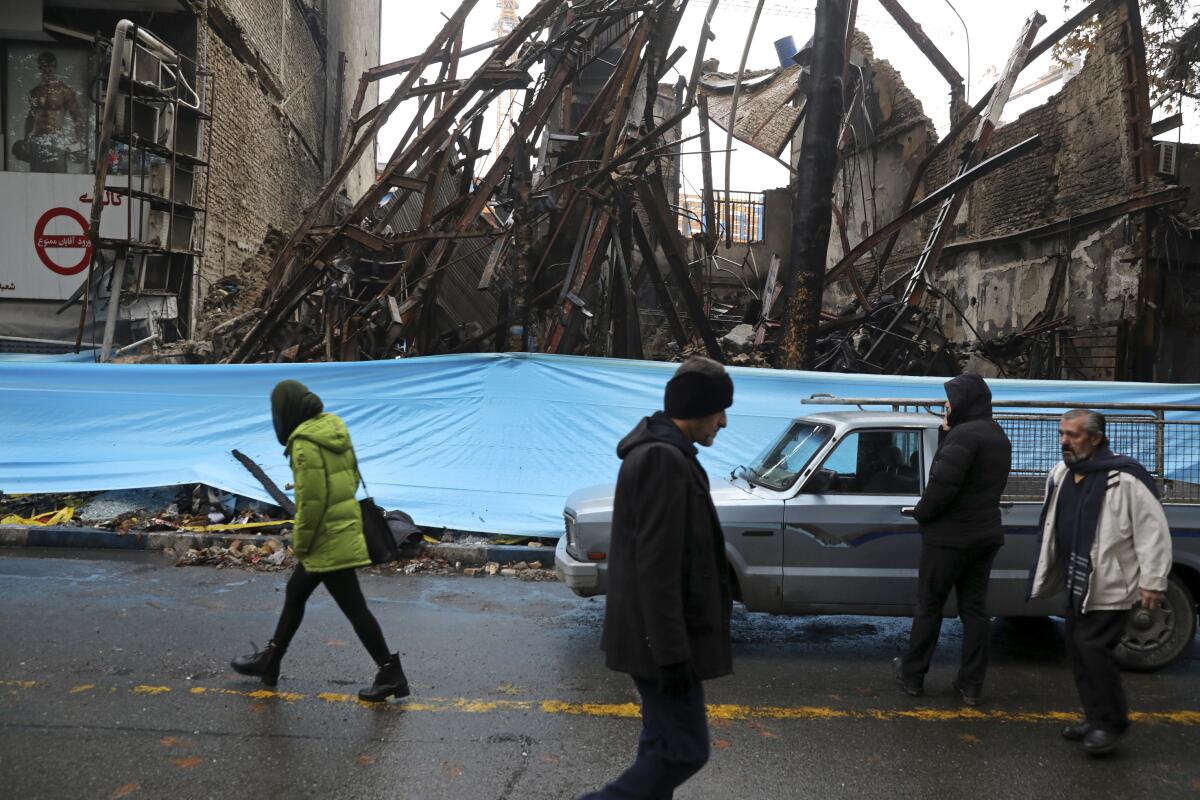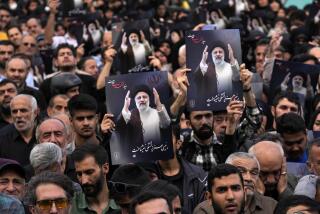Iran admits killing ‘rioters’ during gas-price protests

- Share via
DUBAI, United Arab Emirates — Iran acknowledged for the first time Tuesday that its security forces shot and killed protesters across the country to put down demonstrations last month over the sharply increasing price of gasoline — the deadliest unrest since the 1979 Islamic Revolution.
A report by Iranian state television sought to portray those killed as “rioters” or foreign-backed insurgents who threatened military posts, oil tanks and the public. It acknowledged, without assigning blame, that the violence also killed passersby, security forces and peaceful protesters.
However, online videos of demonstrations purport to show security forces firing machine guns and rifles at crowds. Amnesty International believes the unrest that began in mid-November and the ensuing crackdown killed at least 208 people. An Iranian judiciary official disputed the toll Tuesday as “sheer lies,” without offering any evidence to support his position.
The demonstrations show the widespread economic discontent gripping Iran since May 2018, when President Trump imposed crushing sanctions after unilaterally withdrawing the United States from the nuclear deal that Tehran struck with world powers. Speaking to journalists before a North Atlantic Treaty Organization summit in London this week, Trump said — without providing evidence — that Iran has killed “thousands.”
The demonstrations followed months of attacks across the Middle East that the U.S. blames on Tehran. Meanwhile, Iran has begun breaking the limits imposed by the nuclear deal in hopes of pressuring Europe into finding a way for Tehran to sell its crude oil despite the American sanctions.
The state TV report alleged that some of those killed were “rioters who have attacked sensitive or military centers with firearms or knives or have taken hostages in some areas.” Some sought to access arsenals inside the police and military posts, the report said.
In one case, the report said security forces confronted a separatist group armed with “semi-heavy weapons” in the city of Mahshar in southwestern Iran’s Khuzistan province.
The Arab population of the oil-rich province long has complained of discrimination by Iran’s central government, and insurgent groups have attacked oil pipelines there. Iran blamed both area separatists and the extremist group Islamic State for a September 2018 attack on a military parade in the region that killed at least 25 people.
Online video purportedly from the area showed peaceful protests, as well as clashes between demonstrators and security forces, although the protesters appeared to be armed largely with rocks and debris.
“The marshes you see behind me and on the right are where hostile groups were hiding and shooting at the police, but praise to God, the armed forces deftly and vigilantly came to the field and foiled their plots,” Mahshar police chief Col. Reza Papi said in the report.
Separately, a detainee shot and killed a police officer in the province on Tuesday, state TV said, without elaborating.
State TV also acknowledged that security forces confronted “rioters” during the protests in Tehran, as well as in the cities of Shiraz and Sirjan. It also mentioned Tehran’s Shahriar suburb, where Amnesty International on Monday said there had been “dozens of deaths.” It described the suburb as probably one of the areas with the highest death tolls in the unrest. Shahriar has seen heavy protests.
Amnesty offered no breakdown for the deaths elsewhere in the country, although it said “the real figure is likely to be higher.”
Iranian judiciary spokesman Gholamhossein Esmaili disputed Amnesty’s death toll.
“I bluntly say that numbers and figures given by hostile groups are sheer lies,” he told reporters. “Real statistics are seriously different from what they announce, and numbers are far less than what they claim.”
However, Esmaili — like every other Iranian official since the crackdown — offered no evidence to support his claim, nor did he give any information on casualties. A United Nations agency also has said it fears the unrest may have killed “a significant number of people.”
The Iranian official also said the “majority of the detainees” from the protests had been released, without offering any numbers. One lawmaker previously said he thought more than 7,000 people had been arrested.
The death toll of at least 208 makes it the bloodiest unrest in Iran since the Islamic Revolution. The 2009 Green Movement protests that followed a disputed presidential election drew millions to the streets but saw far less killing.
The demonstrations began Nov. 15 after the government raised minimum gasoline prices by 50% to 15,000 Iranian rials per liter. That’s the equivalent of nearly 50 cents a gallon. After a monthly 60-liter quota, it costs 30,000 rials a liter. That’s about 90 cents a gallon. An average gallon of regular gas in the U.S. costs $2.58 by comparison, according to AAA.
Despite decades of economic woes, cheap gasoline is practically considered a birthright in Iran, home to the world’s fourth-largest crude oil reserves. That disparity, especially given its oil wealth, fueled the anger felt by demonstrators.
Iranians have seen their savings chewed away by the rial’s collapse from 32,000 to $1 at the time of the 2015 nuclear accord to 127,000 to $1 today under the renewed U.S. sanctions. The cost of daily staples also has risen.
On Tuesday, Trump kept up the pressure, alleging without evidence that Iran was “killing perhaps thousands and thousands of people right now as we speak.” The protests largely have subsided, and no group has offered estimates that high.
“I think it’s a terrible thing and I think the world has to be watching,” Trump said.
Sitting beside French President Emmanuel Macron later, Trump told journalists that Iran is having “massive riots and protests all over the country.”
Asked if the U.S. supported the protesters, Trump said: “I don’t want to comment on that, but the answer is no.” He later clarified he meant the United States offered them no financial support, though it backed their aspirations.
In Tehran, Iranian President Hassan Rouhani met with Yusuf bin Alawi, Oman’s foreign minister. Alawi met U.S. Secretary of State Michael R. Pompeo last week in Washington. Oman, a sultanate on the eastern edge of the Arabian Peninsula, has served as an interlocutor between Iran and the U.S. in the past.
Rouhani said the U.S. offers only slogans in its leaders’ speeches that have led nowhere, while trying to cut deals in private that go against them.
Rouhani may end up traveling to Tokyo for a meeting with Japanese Prime Minister Shinzo Abe to seek a way to save the nuclear deal, the news agency Kyodo reported, citing an anonymous official. Abe traveled to Iran in June but received a lecture from Supreme Leader Ayatollah Ali Khamenei on how Trump couldn’t be trusted. During that meeting, a suspected Iranian limpet mine attack damaged a Japanese oil tanker.
More to Read
Sign up for Essential California
The most important California stories and recommendations in your inbox every morning.
You may occasionally receive promotional content from the Los Angeles Times.










